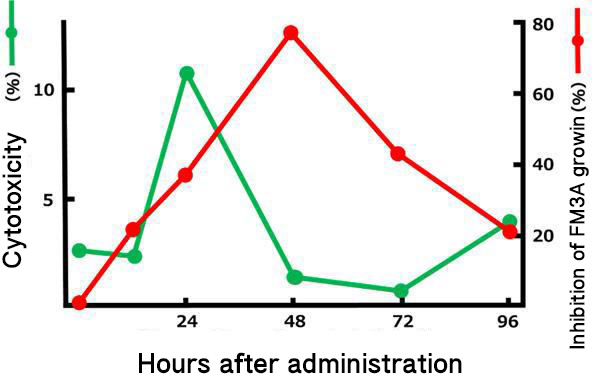Role of immune system to avoid risk of infection & cancer:

“Immunity” is one of the defense systems to keep our health. The immune system works to protect the body from external enemies such as pathogens (bacteria and viruses). The immune system is basically divided into two types: innate immunity and acquired immunity. “Innate immunity” reacts quickly to pathogens that have invaded the body, such as macrophage cells and natural killer (NK) cells. NK cells start attacking when they recognize invading pathogens. Macrophages prey on recognized pathogens and break them apart, and at the same time, when innate immunity alone cannot deal with them, inform them of acquired pathogens for help.
The immune system plays an important role in maintaining health, but its function declines with age. The graph shows the relationship between age and immune function, infectious disease and cancer risk. Immune function peaks in the 20’s and 30’s and thereafter declines with age. On the other hand, the risk of infection and cancer rises when immune function declines. In other words, reduced immune function increases the risk of pathogen invasion and carcinogenesis. Maintaining a high level of immune function is very important to staying healthy.

Recently, there are lactic acid bacteria and mushrooms (β-glucan) as food materials that enhance immune function, but in fact, Asaigermanium has been studied as a material related to immunity from many years ago. Here, are some of the research conducted by Asai Germanium Research Institute.
Asaigermanium induces interferon-γ:
Experiment ① Interferon-γ production inducing effect:
Interferons, especially interferon-γ, are important substances that activate innate immunity such as macrophages and NK cells. The effect of Asaigermanium on interferon-γ induction was addressed relatively early in immunity studies.
Test: Twelve healthy people of various ages intook Asaigermanium and examined the changes in the amount of interferon in their blood.
Result: Despite individual differences, interferon titers rose for all, regardless of age and gender, and peaked around 30 hours later.

Activation of innate immunity (NK cells):
Experiment ② Asaigermanium activates NK cells:
NK cells are an abbreviation for “natural killer cells” and literally means “born killer.” When they recognize invading pathogens or abnormal cells, they start attacking quickly.
Test: Nine healthy people were divided into three groups of three, and each subject intook 25, 50, and 100 mg / kg of Asaigermanium, and the NK cell activity of peripheral blood lymphocytes was measured.
Result: All groups showed that NK cell activity increased one day after ingestion of Asaigermanium, and that activity was maintained for four days thereafter.

Activation of innate immunity (macrophage):
Experiment ③ Spleen NK cell activity and intraperitoneal macrophage activation in mice:
Macrophages play a role in recognizing invaders such as bacteria that have invaded the body, prey on them and decompose them, and at the same time transmit information on the invading pathogen to acquired immunity.
Test: Mice were orally administered 300 mg / kg of Asaigermanium and examined for changes in spleen NK cell activity and intraperitoneal macrophage activity.
Result: 24 hours after administration of Asaigermanium, NK activity in the spleen was confirmed to have a unimodal potentiating effect. In addition, the activity of intraperitoneal macrophages peaked at 48 hours, 24 hours after NK activity.

In this experiment, the number of macrophages in the abdominal cavity did not increase, so it is considered that macrophages were activated by interferon induced by intake of Asaigermanium.
Immunity and Asaigermanium:
Introducing a study that intake of Asaigermanium induces interferon-γ production and activates innate immunity, NK cells and macrophages, is only a small part of the immune system as a whole. As shown in the illustration at the beginning, there are a wide variety of cells involved in immunity. Research into the complex and systematic immune system and its relationship to Asaigermanium is ongoing.
References
1.Toxiocology and Phase I Studies on a Novel Organic germanium compund, Ge-132
Miyao, K., Onishi, T., Asai, K., Tomizawa, S., & Suzuki, F. Current Chemother. Infect. Dis. Vol.2 1980
2.Pharmacological Activity of Organic Germanium Compound Ge-132 (Review) (in Japanese)
Hiroshi Sato, Kohei Miyao
Medicine and Pharmacy 9 (3) 1983
3.IFN induced ability and NK cells in mice organogermanium compound Ge-132, macrophage activating effect (in Japanese)
Hisashi Aso, Fujio Suzuki, Takahiro Yamaguchi, HayashiYoshio, Ebina TakuSaburo, Ishida Nakao male
Cancer and Chemotherapy 9 (11): 1976- 1980, 1982
4.Yodosha “I understand immunology” (in Japanese)
5.Toyo Medical School “Science of Organic Germanium” (in Japanese)
6.Interferons as immunomodulators (in Japanese)
Katsuo Kumagai, Sumio Arai
Protein, Nucleic Acid, Enzyme, Supplement 25 1981
7.Interferon-Induced Gamma By S.Aureus Protein A Augments Natural Killing And ADCC
Catalona WJ, Ratliff TL, McCool RE.
Nature 1981 May 7; 291 (5810): 77-9
8.Pneumoconiosis patients in the 2-carboxyethylgermanium sesquioxide (Ge-132 ) IFN -induced and NK cell activity and ADCC activity enhancement by oral administration (in Japanese)
Hisashi Aso, Hiroyuki Kobayashi, Kyoko Sugiyama, Kenichi Saito, Chiyoya Keizo Ishida Nakao male
Japan Disaster Medicine Journal 36 (3): 233-237, 1988
9.Peripheral blood monocyte function in cancer patients from the viewpoint of O 2 -producing ability (in Japanese)
Ryunosuke Kanshiro, Ryuichiro Tamada, Yoichiro Hiramoto, Nosunari Abe, Takayuki Nozuka, Akira Nakagawa, Kiyoshi Iguchi
Medicine and Pharmacy, 9 (6): 1845-1847 , 1983
10.Potelligent antibody as a next-generation antibody drug (in Japanese)
Shitara Kenya
pharmaceutical magazine 129 (1) 3-9, 2009
11.New interferon inducer (in Japanese)
Takuzaburo Ebina
Protein, Nucleic Acid, Enzyme, Supplement 25 1981

